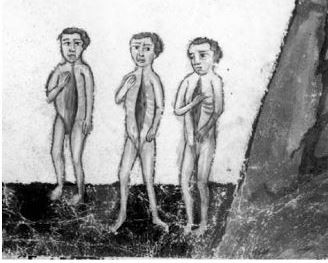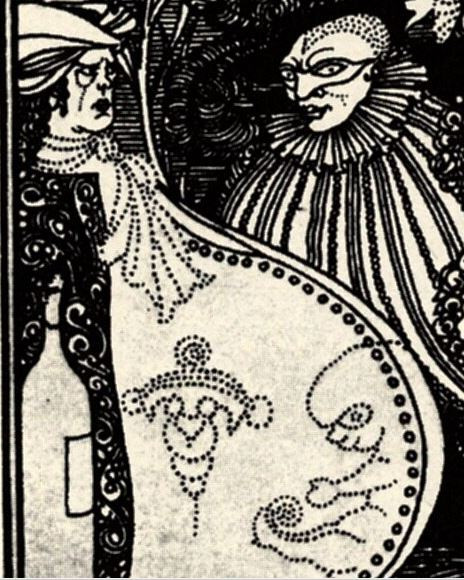“I see that in a lot of paintings of women from those periods [...]. That’s all they [the Renaissance artists] could get away with”, artist John Craig said, discussing how the pose of Raphael’s 1507 Saint Catherine of Alexandria does, perhaps, subtly imply autoeroticism (Tyler-Ameen 2012 – for an interpretation of Craig’s reuse of Saint Catherine in combination with the ecstatic-eyed woman in Jean-Baptiste Greuze’s The Souvenir, see Paolucci 2017). An example of that may be Titian’s Venus of Urbino, especially if compared with Giorgione’s Sleeping Venus: the latter being asleep, her hand has probably ended up near her genitals by chance and could be anywhere else; Titian’s Venus has her eyes open, and shining with seductiveness (Nova 2002, 179), which charges the placement of her hand with significance – she is either performing a luring gesture or self-fondling. Alessandro Nova does also speculate that Georges Bataille would be intrigued by her accessories – Bataille, to whom a necklace would seem to decapitate Édouard Manet’s Olympia; Olympia whose fingers are widened, actually shielding her sex as she defiantly stares at the viewer; see chapter four in Charles Bernheimer 1997, for more on “‘the irritating enigma’ of Olympia’s gaze” (Bernheimer 1997, 107), “the dramatic ambiguity of Olympia’s manual gesture” (Bernheimer 1997, 119), and the comparison with Titian’s Venus.) But, sexuality-wise, the most revolutionary gesture that a Renaissance-painted woman ever performed is, according to James Miller, another.
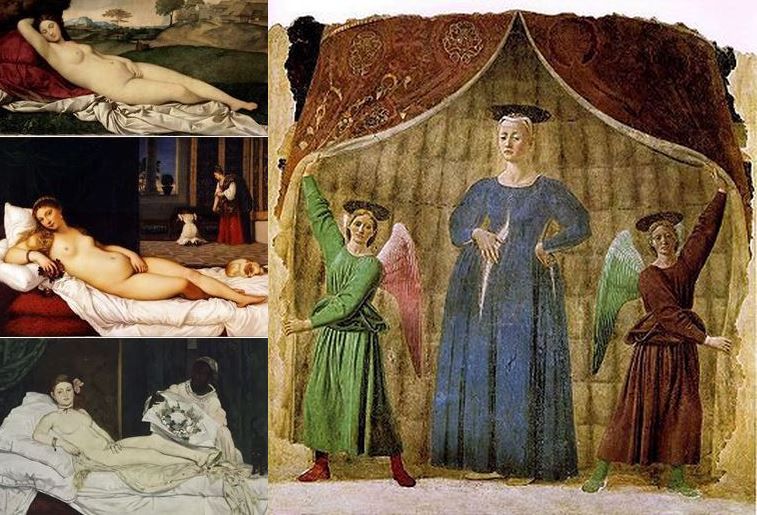
1| a. Giorgione, Sleeping Venus, 1510, Gemäldegalerie Alte Meister, Dresden; b. Titian, Venus of Urbino, 1534, Galleria degli Uffizi, Florence; c. Édouard Manet, Olympia, 1863, Musée d’Orsay, Paris.
2 | Piero della Francesca, Madonna of Childbirth, ca. 1455-1465, currently housed in a purpose-built space in Monterchi.
On Piero della Francesca’s “erotically suggestive” Madonna del Parto, Miller says:
Mary’s delicate hands are surprisingly active [...]. They are “caught” in the act of opening her shift lengthwise to create a vagina-shaped opening over her swelling womb as if she were intent on revealing the secret chamber of the Incarnation. She doesn’t bray out ‘I’m GOD’, of course, but her prophetic mime of vaginal dilation implies a continuity with the Divine at a miraculously physical level (Miller 2006, 228).
Stating “I’m GOD” is what prostitute Madame Edwarda does in Bataille’s 1937 eponymous short story, as she opens her sex and tells the narrator to kiss it. Edwarda is, to Miller, “the ruined, secular version” of Piero della Francesca’s sacred icon (ivi); and kiss her sex the narrator does, afterwards realising that, in so doing (in this non-penetrative, non-heteronormative, queer sexual practice – considerations mine), he has felt, indeed, that he was in the presence of God.

3 | Gilbert & George, Eight Shits, colour photograph, 1994.
4 | Aubrey Beardsley, Title page to The Story of Venus and Tannhäuser, pen and ink drawing, 1895: note that Venus is called “Goddess and Meretrix”.
Edwarda’s sex is unidealised. It is hairy, and is compared to a wound. Miller’s comparison between Piero’s Madonna and Bataille’s character is what I have recentely underlined: “[John Craig’s comment on Renaissance paintings] is surely a pertinent remark: women’s hands in Renaissance paintings have told revolutionary tales” (see Paolucci 2017; cfr. Paolucci 2018, where the theme of rebellious unpleasantries in women’s representations is extensively discussed).
In describing the wall-sized photographs in Gilbert & George’s 1995 exhibition The Naked Shit Pictures, Robert Rosemblum and David Sylvester compared “this mammoth installation to Renaissance frescoes ‘in which the settings for the groupings of nude figures were not the usual columns and arches but structures erected from enlargements of turds’, thereby producing in their viewers a supposed rush ‘from the scatological to the eschatological’” (Krauss 1996, 395-396); and, in his unfinished novel The Story of Venus and Tannhäuser (1895), Aubrey Beardsley describes the Goddess’s worshippers adoring her faeces, her ear wax, and everything from her body that ought to be considered revolting.
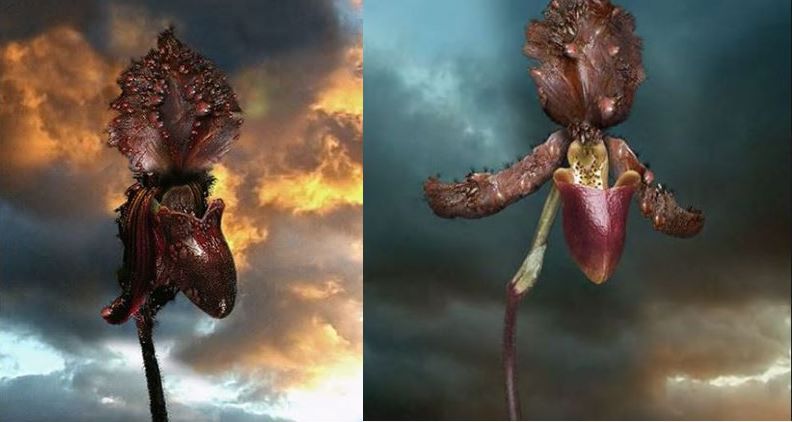
5| Mat Collishaw, Orchid 1 & 2, C-type print, 2005.

6 | Installation view of Mat Collishaw’s Shooting Stars at Haunch of Venison in London, 2008.
The “lines between beauty and repulsion” (Collishaw 2005) have also been blurred in works built around male characters. Such is the case with Mat Collishaw’s 2005 Infectious Flowers: images of skin diseases from dermatology books digitally grafted to photographs of flowers, inspired by Jean Genet’s cellmate, whose wounds and pustules Genet described “as embellishments”, reminding him of “flowers or medals adorning a male jacket”. Nevertheless, Collishaw’s strong interest in the theme of women in the Victorian era points me toward a female-flavoured interpretation (namely, I am thinking of the Collishaw exhibition that took place at the Freud Museum in London in 2010, titled Hysteria; and, most notably, of the 2008 installation Shooting Stars: “a series of haunting images of Victorian child prostitutes are projected in rapid succession onto walls coated with phosphorescent paint. The ghost of these pictures is burnt onto the walls and gradually fades over time. Occasionally a projector will drag the image across the wall before leaving it burning bright at the end of a trail of light. This has a similar effect to the arc of a shooting star. The lives of these girls sadly often resembled their presentation here” – Collishaw 2008): I am inclined to associate the Flowers with the theme of prostitution-caused sexually transmitted diseases in the 19th century, their blend of beauty and repulsion reminding me of the syphilis marks on Edgar Degas’s Little Dancer Aged Fourteen, extensively discussed in Paolucci 2018 (drawing on Mori 2004).
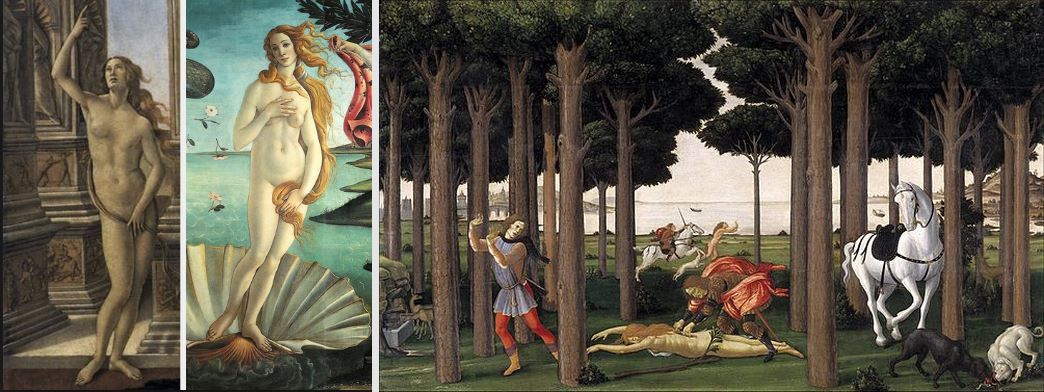
7 | Left to right: Sandro Botticelli, The Calumny of Apelles (det.), 1494-1495, Galleria degli Uffizi, Florence; Sandro Botticelli, The Birth of Venus (det.), 1484-1486, Galleria degli Uffizi, Florence.
8 | Sandro Botticelli, The Story of Nastagio degli Onesti, Painting Two, 1483, Prado Museum, Madrid.
Coming back to the Renaissance, both Botticelli’s newborn Venus and his Truth (the latter appearing in The Calumny of Apelles) perform the “Pudica Gesture”; but, while Venus’s other arm is graciously bent, Truth’s is pointing upwards, to the panelled ceiling: more precisely, to the portion of the panelled ceiling decorated with the sequences of the Story of Nastagio degli Onesti. (For a complete mapping of the decorated ceiling in the painting, see Agnoletto [2013] 2014. The Nastagio degli Onesti scenes are marked S1-S6 on the Agnoletto map.) This Boccaccio tale features a woman ferociously killed (as a punishment for saying no to a man); Truth can therefore be considered to be marking the passage from the Goddess Who Is Triumphantly Born to the Woman Who Gets (Unfairly) Killed. Botticelli had illustrated the tale in 1483, by a series of four paintings; in discussing the second painting, where Nastagio opens up the woman’s back with a knife, Georges Didi-Huberman points out how having her back ripped is part and parcel of her shaming: an ‘inversion’ of the famous ‘redeeming’ wound in a man’s side, in Christ’s side (Didi-Huberman [1999] 2001, 66).
In the light of that, the interpretation that Kent Brintnall offers of the wound in the hero’s abdomen – a wound on the front of the body, like Christ’s – in Quentin Tarantino’s Reservoir Dogs is simply breathtaking: a feminine wound, just like Christ’s. As I refer the reader to Brintnall 2004 for an analysis – based on Julian of Norwich’s Revelations of Divine Love – of how Mr. Orange’s wound opens the floor to pietas and subsequent queerness (as in unexpected physical tenderness), I wish to add my own observations. First, images of crosses appear over the course of the movie (see caption to Figure 9). Second, Mr. Orange’s wound is feminine also in that its red colour comes to taint the black and white of the wounded man’s suit: these were the three colours associated with the archetypical Triple Goddess – Virgin (white), Mother (red), and Death (black).

9 | Screenshots from Quentin Tarantino’s Reservoir Dogs, 1992, actors: Tim Roth (Mr. Orange), Harvey Keitel (Mr. White):
a | Mr. Orange’s wound; b | the “Pietà Pose” (Brintnall 2004); c | the wall elements forming cross shapes; d | the wall crucifix in Mr. Orange’s house.
It is discussed in Didi-Huberman's Aprire Venere how Botticelli’s art offers a privileged space for studying the blurring of beauty and repulsion, violence and compassion, spirituality and carnality: there is a touch of cruelty to Botticelli’s grace, Didi-Huberman writes (within the context of a more complex epistemological and phenomenological argument), and all is mixed up in a dreamlike atmosphere (see Didi-Huberman [1999] 2001). I think it is not by chance that author Anne Rice of The Vampire Chronicles fame, a connoisseur of Italian art, made Botticelli a character in her 2001 novel Blood and Gold, where vampire Marius is so in awe of Botticelli that he has to fight off the temptation to bite him and make him one of the Immortals.
10 | “This proto-Surrealistic detail from the second illustration of Inferno (in MS. Holkham misc. 48, p. 43, Bodleian Library, University of Oxford) shows three Vaginal Men opening themselves up for tropologically earnest inspection – and transgressively erotic display – as scandalous embodiments of schism” (Miller 2006, 227).
11 | The Pregnant Man, detail from Aubrey Beardsley, The Cave of Spleen (Canto IV) for The Rape of the Lock, 1896.
I am now coming back to James Miller. Bataille was a medievalist, which is discussed in Miller 2006, analysing Dante Alighieri’s imagery for his Inferno through a Surrealist lens – for example, the treatment reserved for the damned in Circle 8 Bolgia 9. The divisive individuals (among whom the prophet Mohammed), who have sown discord and caused schisms in life, are now suffering the torture of being opened up with swords “all the way from chin to anus”: a punishment that creates
[...] a transsexual freak, a gender synecdoche, a figure of scandalous excess and immodesty comparable to the anthropomorphized ‘private parts’ that turn up as public parts – vaginal faces, labial mouths, penile thumbs, phallic heads – in the erotic art of Dalí, Magritte, and Picasso (Miller 2006, 225).
To these examples I would like to add a ‘distorted photograph’ of Carlo Rim shot in 1929 by André Kertész, that according to Amy Lyford “exaggerates and wounds”, at the same time, Rim’s masculinity:
The repeating stack of torsos accentuates Rim’s manhood, taking the shape of a great phallic object. Yet this phallus gapes open: the vertical torso is punctuated by a series of folds (produced by his jacket’s lapels) that look suspiciously like the shape of a vagina [...]. These openings mimic the imagined cut of castration (Lyford 2007, 108).
“At least one medieval artist,” Miller continues, “the anonymous illuminator of the late fourteenth-century Holkham Hall manuscript of the Commedia, anticipated this Surrealist theme in his transgressively erotic depiction of Mohammed and three other cleft shades in the Ninth Bolgia as Vaginal Men fingering or spreading their new ‘labia’”(Miller 2006, 225). The fact that “the neat surgical slice is [...] stretched and mangled by human hands [...] operating independently of the demon’s” (ivi, 212) means that “a strange but sacred joy” can indeed “issue from the birth canal of agony like an exultant cri de coeur from the panting mouth of a martyr” (ivi, 230), which is all the more significant in Mohammed’s case (“The birth of joy from cataclysmic torment and division was prophesied by Mohammed himself in the eighty-fourth Sura of the Koran, an apocalyptic passage known as ‘The Rending’ (Al-Inshiqaaq)”) and also provides a further link with Surrealism (“Devotees of the Surrealist religion would presumably defy the old moral logic of purgation by seeking pleasure through pain in a Sadean frenzy of immorality, sacrilege, and torture” (ivi, 207).
“Transsexual freaks”, to use Miller’s words, can be found in the “Cave of Spleen” described by Alexander Pope in his 1712 poem The Rape of the Lock: an unearthly women’s place, “obvious metaphor for premenstrual syndrome, or better yet, for hysteria as it was understood before psychoanalysis” (Paolucci 2018), to which, upon the heroine having a lock of her hair cut off by a man without her consent, a gnome flies down “to fetch the rage and tears she needs in order to claim it back” (Paolucci 2017), and in which “Men prove with Child, as pow’rful Fancy works” (Pope, The Rape of the Lock IV, 54). Allison Muri’s explanation for the presence of pregnant men in the Cave of Spleen is fascinating: “This mixing of gender roles, along with the Baron’s ‘rape’ of Belinda’s lock, seems to allude to the ‘chemical wedding’ of King Sol and Queen Luna, the initial step leading to their union as a hermaphrodite”; the alchemical movement was strong in England (as extensively discussed by Dame Frances Yates), and Pope was a freemason with knowledge of the Rusicrucian alchemy (Muri 2016, 197). My own explanation, though, relies on the fact that the Cave is a place where revolutionary things happen.
The source of Belinda’s fury, what enables her to fight her violator, is allegedly her menstruation “thus far thought of only as what potentially enables her to conceive children” (Paolucci 2018). In the Cave, women can be free of the social expectations of them becoming mothers, and, by virtue of their “pow’rful Fancy”, enhanced by their melancholy fits (see Ead. 2017), they play with gender roles and create men who do just that.

12 | William Hogarth, Cunicularii, or The Wise Men of Godliman in Consultation, etching, 1726.
13 | Thomas Rowlandson, Dr. John Howard and Mr. St. Andre in Consultation Upon Mrs. Mary Toft, hand-coloured etching, 1726.
14 | on the left: Anonymous, The Doctors in Labor or a new Whim Wham from Guilford, twelve-stanza illustrated poem, 1726. On the right, from top to bottom: the first stanza (Mary is carried in triumph by three doctors, one of them in a buffoon costume), the third stanza (a rabbit-holding Cupid beside Mary’s bed, as if to signify that she has been miraculously impregnated), and the fourth stanza (two women attending Mary).
15 | John Faber Jr. after John Laguerre, Mary Toft (née Denyer), mezzotint, ca. 1726, National Portrait Gallery, London.
Whatever the reason for the “Men with Child” in Pope’s Cave, England certainly had a fascination with strange pregnancies. In 1663, character Lord Nonsuch being tricked into believing that he is pregnant had been a key element to the plot of John Dryden’s comedy The Wild Gallant:
Now terrified, he believes he faces as much danger as any woman [...]. Suddenly compassionate towards her apparent plight as a single mother, he announces that he has one wish before he gives birth: to find a husband for [his pregnant daughter] Constance (Forman Cody 2005, 88).
But it is in the eighteenth-century, as stated by the title itself of Forman Cody 2005 (Birthing the Nation. Sex, Science and the Conception of Eighteenth-Century Britons), that the fascination grows really strong: a moment in English history that witnesses the rise of man-midwifery, relying on men’s allegedly better rationality and therefore deemed superior. The obsession with rationality can be considered the root of eighteenth-century England’s thirst for everything that was uncanny and bizarre:
The very psychic and cultural transformations that led to the subsequent glorification of the period as an age of reason or enlightenment – the aggressively rationalist imperatives of the epoch – also produced, like a kind of toxic side effect, a new human experience of strangeness (Castle 1995, 8).
Rationality did certainly not prevent doctors from believing the fraudulent tale in 1726 of peasant Mary Toft giving birth to rabbits. The abundant works by British artists immortalising the story have mostly focused on mocking the doctors, and something really dark and disturbing has not been addressed: the fact that Mary, as it turned out, was a victim in all that, and endured horrible physical pain. Avid for the money that Mary’s prodigy status could bring in, her mother-in-law, with the complicity of other women, placed rabbit parts (“the Nails of the Paws were most of them exceedingly sharp”) inside her vagina or even up into her uterus, to remain hidden there for several weeks (Harvey 2015). Once the viewer knows this much, the presence of the two women at Mary’s sides in the fourth stanza of the illustrated poem narrating the story [see Fig. 14] takes on a very sinister meaning.
Mary Toft’s story is featured in Emma Donoghue’s The Woman Who Gave Birth to Rabbits, a book of short stories about intriguing cases occurred throughout history – not only in the eighteenth century – in the British Isles. Hannah K. P. McGregor has interestingly identified Ireland as the privileged place for freakness, queerness, and the uncanny in the stories that Donoghue has selected and retold:
Through her stories of witches, miraculous miniature girls, blind poetesses and gender-shifting tribades, Donoghue re-invents Irish history to make space for the queer, the grotesque and the uncanny. As the home of the Unheimlich, Ireland is rendered uncanny itself, a nation at once familiar and rendered unnervingly different through being populated with Donoghue’s outlandish characters (McGregor 2009).
Having mentioned women novelists (Donoghue, Rice), and having discussed freaks, I wish to include Carola Maria Wide’s observations about how Angela Carter’s tale Wolf-Alice is not the tale of a werewolf, but a story where woman and wolf blur, which is also what occurs in some works by artist Kiki Smith (Wide 2014). There are also works by Smith where the feral quality of her women is more subtle and discreet, not immediately apparent – as is the case with the blackened hands and feet in her collage Gathering.
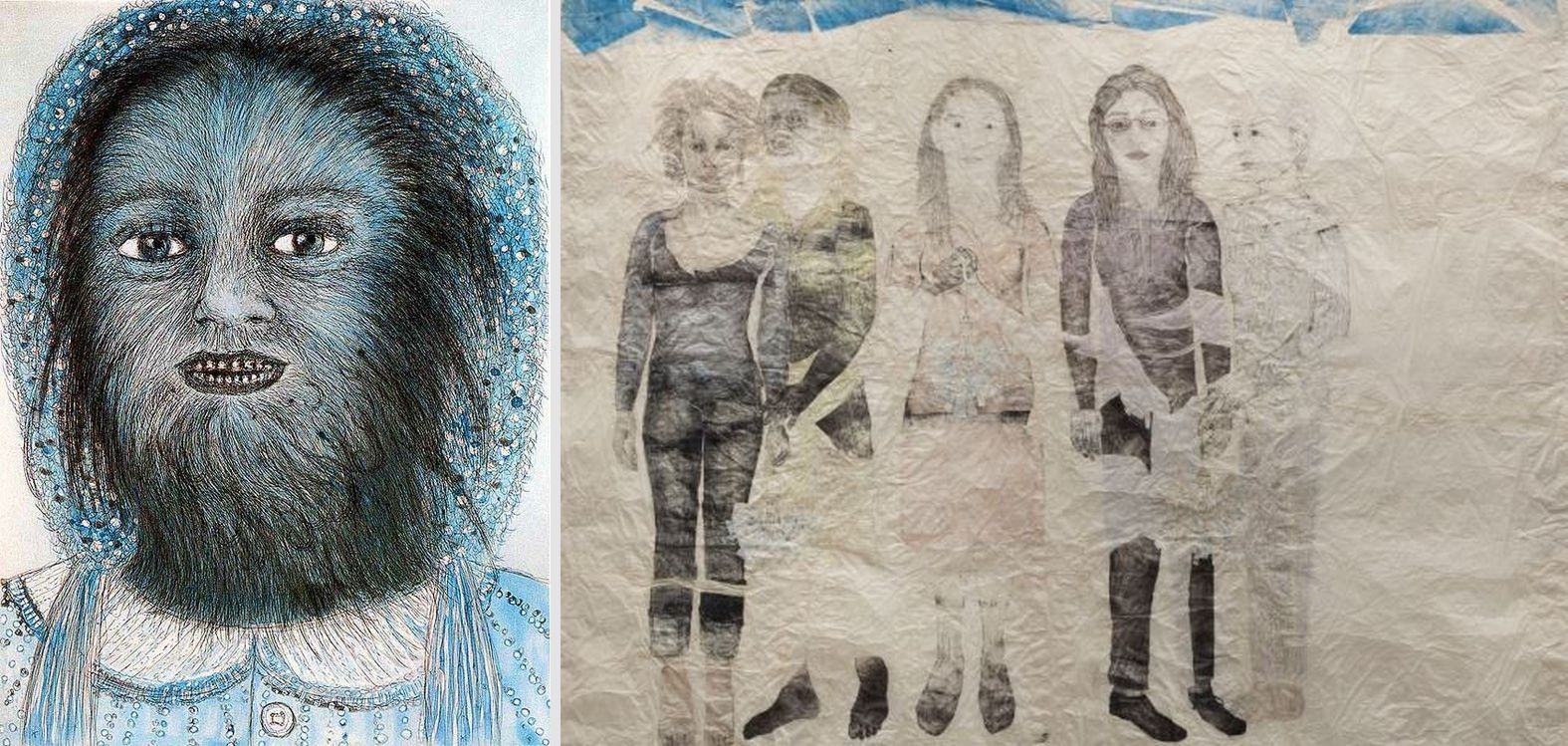
16 | Kiki Smith, Wolf Girl, colour etching, 1999, The Metropolitan Museum of Art, New York.
17 | Kiki Smith, Gathering, collage on Nepalese paper, 2014, Galleria Lorcan O’Neill, Rome.
*This paper, whose title is a double homage to McGregor 2009 and Forman Cody 2005, is a quick overview that relies most notably on the power of the images themselves, which I think is fitting for a paper written for "Engramma"; and I am especially glad that I have had the opportunity to resume themes from my past research work.
Bibliography and webography
- Agnoletto [2013] 2014
S. Agnoletto, Botticelli orefice del dettaglio. Uno status quaestionis sui soggetti del fondale della Calunnia di Apelle, “La Rivista di Engramma” 120, 8 (October 2014) [2nd Edition. First appeared on “La Rivista di Engramma” 104, 2 (March 2013)]. - Bernheimer 1997
C. Bernheimer, Figures of III Repute: Representing Prostitution in Nineteenth-Century France, Durham (NC) 1997. - Brintnall 2004
K. L. Brintnall, Tarantino’s Incarnational Theology: Reservoir Dogs, Crucifixions and Spectacular Violence, “CrossCurrents” 54, 1 (Spring 2004), 66-75. - Castle 1995
T. Castle, The Female Thermometer. Eighteenth-Century Culture and the Invention of the Uncanny, New York 1995. - Forman Cody 2005
L. Forman Cody, Birthing the Nation. Sex, Science and the Conception of Eighteenth-Century Britons, Oxford 2005. - Collishaw 2005
M. Collishaw, Infectious flowers, description in mattcollins.com official website, 2005. - Collishaw 2008
M. Collishaw, Shooting stars, description in mattcollins.com official website, 2008. - Didi-Huberman [1999] 2001
G. Didi-Huberman, Aprire Venere. Nudità, sogno, crudeltà [1999], italian translation by S. Chiodi, Torino 2001. - Harvey 2015
K. Harvey, What Mary Toft Felt: Women’s Voices, Pain, Power and the Body, “History Workshop Journal” 80, 1 (October 2015), 33-51. - Krauss 1996
R. Krauss, Informe without Conclusion, in Z. Kocur, S. Leung (eds.), Theory in Contemporary Art since 1985, Oxford 2005, 395-407. First appeared on “Art Forum” 78 (Fall 1996), 89-105. - Lyford 2007
A. Lyford, Surrealist Masculinities. Gender Anxiety and the Aesthetics of Post-World War I Reconstruction in France, Berkeley 2007. - McGregor 2009
H. K. P. McGregor, The Tribad, the Dwarf and the Blind Girl: Queering the Body in Emma Donoghue’s The Woman Who Gave Birth to Rabbits, talk delivered at “Queering Ireland: An Interdisciplinary Conference”, St. Mary’s University, Halifax, September 2009. - Miller 2006
J. Miller, Anti-Dante: Bataille in the Ninth Bolgia, in Id., Dante & the Unorthodox: The Aesthetics of Transgression, Waterloo (ON) 2006, 207-248. - Mori 2004
G. Mori, Degas tra antico e moderno, Firenze 2004. - Muri 2016
A. Muri, Of Words and Things: Image, Page, Text, and The Rape of the Lock, in D. Nichol (ed.), Anniversary Essays on Alexander Pope’s The Rape of the Lock, Toronto 2016, 167-217. - Nova 2002
A. Nova, Verso la fabbrica del corpo: anatomia e ‘bellezza’ nell’opera di Leonardo e Giorgione, in C. Bertelli, F. Mazzocca, and M. Natale (a cura di), Lezioni di storia dell’arte, volume 2: Dall’Umanesimo all’Età Barocca, Milano 2002, 155-183. - Paolucci 2017
M. Paolucci, British Poets and American Rockstars. A Journey through the Cave of Spleen, “La Rivista di Engramma” 149, 9 (September 2017). - Paolucci 2018
M. Paolucci, The British Uncanny. Reusing Surrealist Energies in Jessica Harrison’s Art, “La Rivista di Engramma” 158, 7 (September 2018). - Tyler-Ameen 2012
D. Tyler-Ameen, ‘Mellon Collie’ Mystery Girl: The Story Behind an Iconic Album Cover, NPR, December 7, 2012. - Nide 2014
C. M. Wide, The Female Genius. Voices and Images in Angela Carter’s and Kiki Smith’s Re-Imaginations of Little Red Riding Hood. Author’s Master’s Thesis in English Studies at the Faculty of Philosophy of University of Vaasa, 2014.
English abstract
From an author who has so far focused on women-related themes, an essay that calls men into play, and of which freakness and queerness are absolute protagonists. Starting with discussing the startling details in some Renaissance paintings of women, the work covers Gilbert & George’s use of the Abject as a religiosity-awakening tool, Mat Collishaw’s disturbing Flowers, the special significance taken on by the Wounded Hero archetype in Quentin Tarantino’s Reservoir Dogs, the treatment reserved for the damned in Dante’s Ninth Bolgia, and finally the men unexpectedly found in such a female-connoted place as Alexander Pope’s “Cave of Spleen” – via whom the author circles back to the representation of women, discussing the frenzy over Mary Toft’s alleged miraculous pregnancies in eigtheenth-century England.
key words | queer; gender studies; eroticism
La Redazione di Engramma è grata ai colleghi – amici e studiosi – che, seguendo la procedura peer review a doppio cieco, hanno sottoposto a lettura, revisione e giudizio questo saggio
(v. Albo dei referee di Engramma)
Per citare questo articolo / To cite this article: M. Paolucci, Queering the Body, Birthing the Nation, Gendering God. An Atlas, “La Rivista di Engramma” n. 168, settembre/ottobre 2019, pp. 131-143 | PDF
